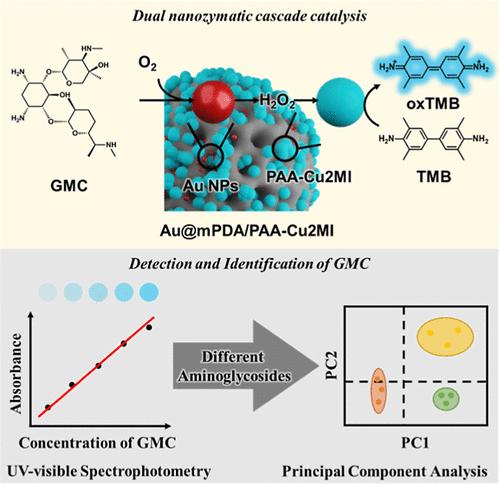双纳米酶级联全系统特异性比色检测氨基糖苷类抗生素
IF 6.7
1区 化学
Q1 CHEMISTRY, ANALYTICAL
引用次数: 0
摘要
抗生素污染一直是环境监测中的重要问题。基于纳米酶的比色传感器可以为现场检测提供有价值的支持。然而,能够使用单一材料识别一整类特定抗生素的传感元件的发展提出了相当大的挑战。在这项工作中,我们提出了一种区隔化的双纳米酶级联复合材料(Au@mPDA/PAA-Cu2MI, AmPC),用于氨基糖苷类抗生素(AGs)的比色检测,并详细分析了双酶体系的催化机制。AmPC复合物具有类似葡萄糖氧化酶(aGOx-like)和过氧化物酶(POD-like)的活性。在此过程中,具有糖结构的AGs可作为反应的初始底物,生成的H2O2作为比色检测的第二底物。以庆大霉素(GMC)为概念验证,建立了0.1 ~ 10 μg/mL的检测范围,检出限(LOD)为91 ng/mL。此外,我们验证了其他AGs的比色响应,并采用主成分分析(PCA)来区分不同的AGs。这种方法使纳米酶能够通过级联机制选择性地识别它们的靶标。此外,它促进了抗生素的同时检测和鉴定,突出了其在现场应用的潜力。本文章由计算机程序翻译,如有差异,请以英文原文为准。

Dual-Nanozyme Cascade for System-Wide Specific Colorimetric Detection of Aminoglycoside Antibiotics
Antibiotic contamination has been a significant concern in environmental monitoring. Nanozyme-based colorimetric sensors can provide valuable support for in-field detection. However, the development of sensing elements capable of identifying an entire class of specific antibiotics using a single material poses a considerable challenge. In this work, we present a compartmentalized dual-nanozyme cascade composite (Au@mPDA/PAA-Cu2MI, AmPC) designed for the colorimetric detection of aminoglycoside antibiotics (AGs), and we analyze the catalytic mechanisms of the dual-enzyme system in detail. The AmPC composite possesses both analogue glucose oxidase-like (aGOx-like) and peroxidase-like (POD-like) activities. In this process, AGs with a sugar structure can serve as the initial substrate of the reaction, while the resulting H2O2 acts as the second substrate for colorimetric detection. Using gentamicin (GMC) as a proof of concept, we established a detection range of 0.1–10 μg/mL, with a detection limit (LOD) of 91 ng/mL. In addition, we validated the colorimetric response for other AGs and employed principal component analysis (PCA) for differentiating among various AGs. This approach enables nanozymes to selectively recognize their targets through a cascade mechanism. Furthermore, it facilitates the simultaneous detection and identification of antibiotics, highlighting its potential for in-field applications.
求助全文
通过发布文献求助,成功后即可免费获取论文全文。
去求助
来源期刊

Analytical Chemistry
化学-分析化学
CiteScore
12.10
自引率
12.20%
发文量
1949
审稿时长
1.4 months
期刊介绍:
Analytical Chemistry, a peer-reviewed research journal, focuses on disseminating new and original knowledge across all branches of analytical chemistry. Fundamental articles may explore general principles of chemical measurement science and need not directly address existing or potential analytical methodology. They can be entirely theoretical or report experimental results. Contributions may cover various phases of analytical operations, including sampling, bioanalysis, electrochemistry, mass spectrometry, microscale and nanoscale systems, environmental analysis, separations, spectroscopy, chemical reactions and selectivity, instrumentation, imaging, surface analysis, and data processing. Papers discussing known analytical methods should present a significant, original application of the method, a notable improvement, or results on an important analyte.
 求助内容:
求助内容: 应助结果提醒方式:
应助结果提醒方式:


